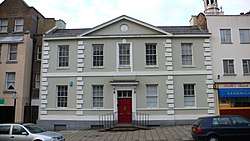Marx Memorial Library
The Marx Memorial Library in London holds more than 43,000 books, pamphlets and newspapers on Marxism, Scientific Socialism and working class history. It is a Grade II listed building.[1]

The Library also features the fresco The worker of the future upsetting the economic chaos of the present, painted by Jack Hastings in 1935 with the assistance of the American artist, Clifford Wight.[2]
Library
The Library opened in 1933 at 37a Clerkenwell Green, formerly home to many radical organisations, and base of an important publishing operation.
The Library now also houses "The Printers Collection" consisting of the archives of the printing and papermaking unions of the UK and Ireland. The collection includes union documents, magazines, photographs, badges and memorabilia. The archive was opened in March 2009 by Derek Simpson Joint General Secretary of Unite and Tony Burke, Assistant General Secretary of Unite.
Building
The building now occupied by the library was originally built in 1738 to house the Welsh Charity School.[3] It was designed by James Steer, and the construction funded by subscriptions. The school moved out to a new home in Gray's Inn Lane (now Gray's Inn Road) in 1772. The building subsequently became (in part) a public house, the Northumberland Arms; and was put to other commercial uses. Part of it was occupied from 1872 onwards by the radical London Patriotic Society; and from 1893 (with the financial backing of William Morris) by the Twentieth Century Press Ltd, publishers of Justice, the newspaper of the Social Democratic Federation. The Press expanded to take over the whole building in 1908–9, and remained until 1922. It was during this period, in 1902–3, that the exiled V. I. Lenin worked in the building, publishing seventeen issues of his newspaper Iskra (Spark) from here.[3] The office he allegedly used is preserved as a memorial to him, although this room did not in fact exist at the time he was there: however, he may have worked in an earlier office partly on its site.[4]
Following a further period of commercial use, the Marx Memorial Library occupied part of the building in 1933, eventually taking over the whole. Through these changes of use, the fabric had undergone numerous alterations and dilapidations, and in 1968–69 the building underwent a major programme of work to restore the 18th-century appearance of the front.[1] The necessary interventions and reconstructions were so drastic that the result is described by the Survey of London as "a modern quasifacsimile – of the original only the outer quoins can have survived".[5]
References
- "Our History". www.marxlibrary.org.uk.
- Temple 2008, pp. 111–13.
- "Marx Memorial Library". www.lonelyplanet.com.
- Temple 2008, p. 112.
- Temple 2008, pp. 107–8.
Bibliography
- Begley, W.W.; Betjeman, J.; Briggs, Asa; Broadwood, Evelyn; Driberg, Tom; Hill, Christopher; Paget, Paul; Spear, Ruskin; et al. (5 May 1967). "A House Worth Saving (letter)". The Times. London. p. 11.(subscription required)
- Rothstein, Andrew (1966). A House on Clerkenwell Green. London: Lawrence & Wishart.
- Temple, Philip, ed. (2008). "Clerkenwell Green". South and East Clerkenwell. Survey of London. 46. New Haven, London: English Heritage. pp. 86–114. ISBN 9780300137279.